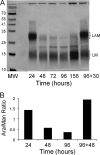Lipoarabinomannan localization and abundance during growth of Mycobacterium smegmatis
- PMID: 21840972
- PMCID: PMC3187192
- DOI: 10.1128/JB.05299-11
Lipoarabinomannan localization and abundance during growth of Mycobacterium smegmatis
Abstract
Lipoarabinomannan (LAM) is a structurally heterogeneous amphipathic lipoglycan present in Mycobacterium spp. and other actinomycetes, which constitutes a major component of the cell wall and exhibits a wide spectrum of immunomodulatory effects. Analysis of Mycobacterium smegmatis subcellular fractions and spheroplasts showed that LAM and lipomannan (LM) were primarily found in a cell wall-enriched subcellular fraction and correlated with the presence (or absence) of the mycolic acids in spheroplast preparations, suggesting that LAM and LM are primarily associated with the putative outer membrane of mycobacteria. During the course of these studies significant changes in the LAM/LM content of the cell wall were noted relative to the age of the culture. The LAM content of the M. smegmatis cell wall was dramatically reduced as the bacilli approached stationary phase, whereas LM, mycolic acid, and arabinogalactan content appeared to be unchanged. In addition, cell morphology and acid-fast staining characteristics showed variations with growth phase of the bacteria. In the logarithmic phase, the bacteria were found to be classic rod-shaped acid-fast bacilli, while in the stationary phase M. smegmatis lost the characteristic rod shape and developed a punctate acid-fast staining pattern with carbolfuchsin. The number of viable bacteria was independent of LAM content and phenotype. Taken together, the results presented here suggest that LAM is primarily localized with the mycolic acids in the cell wall and that the cellular concentration of LAM in M. smegmatis is selectively modulated with the growth phase.
Figures






Similar articles
-
Critical roles for lipomannan and lipoarabinomannan in cell wall integrity of mycobacteria and pathogenesis of tuberculosis.mBio. 2013 Feb 19;4(1):e00472-12. doi: 10.1128/mBio.00472-12. mBio. 2013. PMID: 23422411 Free PMC article.
-
Role of LmeA, a Mycobacterial Periplasmic Protein, in Maintaining the Mannosyltransferase MptA and Its Product Lipomannan under Stress.mSphere. 2020 Nov 4;5(6):e01039-20. doi: 10.1128/mSphere.01039-20. mSphere. 2020. PMID: 33148829 Free PMC article.
-
Lipoarabinomannan mediates localized cell wall integrity during division in mycobacteria.Nat Commun. 2024 Mar 11;15(1):2191. doi: 10.1038/s41467-024-46565-5. Nat Commun. 2024. PMID: 38467648 Free PMC article.
-
Microenvironment of Mycobacterium smegmatis Culture to Induce Cholesterol Consumption Does Cell Wall Remodeling and Enables the Formation of Granuloma-Like Structures.Biomed Res Int. 2019 Apr 15;2019:1871239. doi: 10.1155/2019/1871239. eCollection 2019. Biomed Res Int. 2019. PMID: 31119154 Free PMC article.
-
Controlled expression of branch-forming mannosyltransferase is critical for mycobacterial lipoarabinomannan biosynthesis.J Biol Chem. 2010 Apr 30;285(18):13326-36. doi: 10.1074/jbc.M109.077297. Epub 2010 Mar 9. J Biol Chem. 2010. PMID: 20215111 Free PMC article.
Cited by
-
Potency Increase of Spiroketal Analogs of Membrane Inserting Indolyl Mannich Base Antimycobacterials Is Due to Acquisition of MmpL3 Inhibition.ACS Infect Dis. 2020 Jul 10;6(7):1882-1893. doi: 10.1021/acsinfecdis.0c00121. Epub 2020 May 29. ACS Infect Dis. 2020. PMID: 32413266 Free PMC article.
-
Detection of Mycobacterium avium ssp. paratuberculosis in Cultures From Fecal and Tissue Samples Using VOC Analysis and Machine Learning Tools.Front Vet Sci. 2021 Feb 3;8:620327. doi: 10.3389/fvets.2021.620327. eCollection 2021. Front Vet Sci. 2021. PMID: 33614764 Free PMC article.
-
Mycobacterial outer membrane is a lipid bilayer and the inner membrane is unusually rich in diacyl phosphatidylinositol dimannosides.Proc Natl Acad Sci U S A. 2014 Apr 1;111(13):4958-63. doi: 10.1073/pnas.1403078111. Epub 2014 Mar 17. Proc Natl Acad Sci U S A. 2014. PMID: 24639491 Free PMC article.
-
MmpL3 is the flippase for mycolic acids in mycobacteria.Proc Natl Acad Sci U S A. 2017 Jul 25;114(30):7993-7998. doi: 10.1073/pnas.1700062114. Epub 2017 Jul 11. Proc Natl Acad Sci U S A. 2017. PMID: 28698380 Free PMC article.
-
In Vivo Volatile Organic Compound Signatures of Mycobacterium avium subsp. paratuberculosis.PLoS One. 2015 Apr 27;10(4):e0123980. doi: 10.1371/journal.pone.0123980. eCollection 2015. PLoS One. 2015. PMID: 25915653 Free PMC article.
References
-
- Alderwick L. J., Birch H. L., Mishra A., Eggeling L., Besra G. S. 2007. Structure, function and biosynthesis of the Mycobacterium tuberculosis cell wall: arabinogalactan and lipoarabinomannan assembly with a view to discovering new drug targets. Biochem. Soc. Trans. 35:1325–1328 - PubMed
-
- Alsteens D., et al. 2008. Organization of the mycobacterial cell wall: a nanoscale view. Eur. J. Physiol. 456:117–125 - PubMed
-
- Besra G. S. 1998. Preparation of cell wall fractions from mycobacteria. Methods Mol. Biol. 101:91–107 - PubMed
-
- Betts J. C., Lukey P. T., Robb L. C., McAdam R. A., Duncan K. 2002. Evaluation of a nutrient starvation model of Mycobacterium tuberculosis persistence by gene and protein expression profiling. Mol. Microbiol. 43:717–731 - PubMed
Publication types
MeSH terms
Substances
Grants and funding
LinkOut - more resources
Full Text Sources
Miscellaneous

